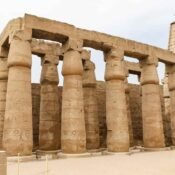
Ancient Egyptian Language
The Ancient Egyptian Language, a branch of the Afro-Asiatic language family, connects Berber and other Semitic languages such as Arabic, Amharic, and Hebrew. As the oldest known language, it stands alongside Sumerian as one of the earliest recorded languages. Originating around 3400 BC during the reign of the Ancient Egyptian Kingdom, it underwent several transformations over the centuries. Initially, it appeared in a demotic form around 1000 BC and later, from the Middle Ages to the 17th century, in the Coptic form. Hieroglyphs, a prominent writing system in temples and tombs, were integral to its usage. Following the 7th-century Muslim invasion, Egyptian Arabic replaced it as the national language.
The language’s history in ancient Egypt is categorized into six distinct periods:
Archaic Egyptian (Before 2600 BC): This early form, seen in the dynastic era, features some of the earliest Egyptian hieroglyphs, including those on Nakada II pottery.
Old Egyptian (2600 – 2000 BC):
This language produced extensive Pyramid Texts and autobiographical writings during the Old Kingdom and the First Intermediate Period. Characterized by triple ideographic, phonetic, and plural determinants, it formed the foundation for later linguistic developments.
Middle Egyptian (2000-1300 BC):
Known as Classical Egyptian, it was employed for hieroglyphic and hieratic scripts, encompassing various texts like the Coffin Text and the Wisdom Text. Its widespread use reflected in regional accents, and its grammar mirrored that of Old Kingdom languages.
Late Egyptian (1300-700 BC):
Emerging in the New Kingdom, this period included diverse religious and secular texts. Its linguistic structure differed significantly from earlier forms and expanded the hieroglyphic script.
Demotic (600 BC – 400 AD):
A vernacular form used during the late Ptolemaic dynasty, Demotic evolved from the Hieratic script used in the northern Delta region.
Coptic Language:
Representing the final stage of ancient Egyptian language evolution, Coptic was primarily written in an adapted Greek alphabet. It became the official language from 200 AD to 1100 AD and was last spoken in the 17th century. Preserved by European scholars during the Renaissance, it continues as a liturgical language in the Coptic Orthodox Church.
Recent Posts
Luxor day tour: Most Illuminated Temples
Discover Luxury Nile Cruises
Designing the Perfect Itinerary for Your Nile Cruise




